Light-material interfaces for self-powered optoelectronics
Abstract
Self-powered wearable optoelectronics are considered as a promising candidate for realizing sustainable and mobile visual communication. Inorganic materials have been utilized to develop various self-powered optoelectronic devices such as piezoelectric nanogenerators, photodetectors, and light-emitting diodes (LEDs). However, inevitable high temperature processes including thermal evaporation, annealing, and epitaxial growth cause serious thermal damage to plastic substrates, hindering the demonstration of a high performance self-powered flexible optoelectronic system. In this paper, we introduce light-material interface (LMI) technologies including nanowelding, laser lift-off, physical interlocking, and interfacial chemistry that can overcome the inherent thermal limit to realize inorganic-based self-powered wearable optoelectronic devices. The working mechanism of these innovative approaches is discussed according to theoretical simulations and scientific findings in previous research. Lastly, LMI-based self-powered flexible optoelectronic components including piezoelectric nanogenerators, thermoelectric energy harvesters, and μLEDs are discussed.


 Please wait while we load your content...
Please wait while we load your content...